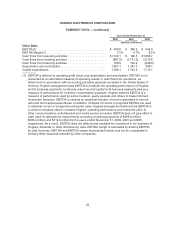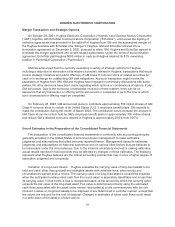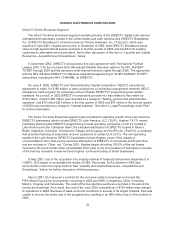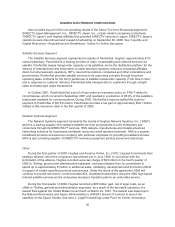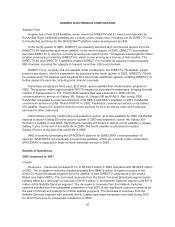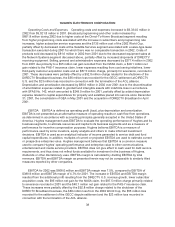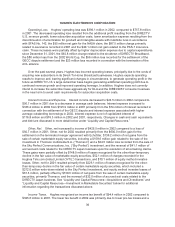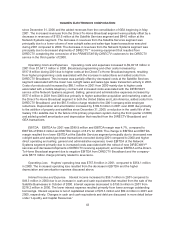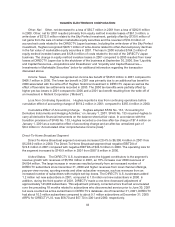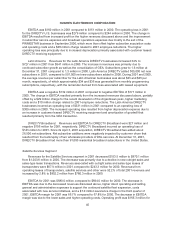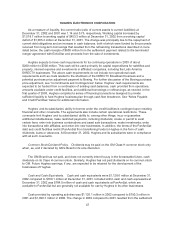DIRECTV 2002 Annual Report Download - page 48
Download and view the complete annual report
Please find page 48 of the 2002 DIRECTV annual report below. You can navigate through the pages in the report by either clicking on the pages listed below, or by using the keyword search tool below to find specific information within the annual report.HUGHES ELECTRONICS CORPORATION
Operating Costs and Expenses. Operating costs and expenses increased to $9,334.0 million in
2002 from $9,021.8 million in 2001. Broadcast programming and other costs increased by
$851.8 million during 2002 due to higher costs at the Direct-To-Home Broadcast segment resulting
from higher programming costs associated with the increase in subscribers and programming rate
increases, higher subscriber service expenses and the $135 million cost of the 2002 World Cup,
partially offset by decreased costs at the Satellite Services segment associated with a sales-type lease
transaction executed during 2001 for which there was no comparable transaction in 2002. Costs of
products sold decreased by $81.6 million in 2002 from 2001 due to the decreased equipment sales at
the Network Systems segment discussed above, partially offset by increased shipments of DIRECTV
receiving equipment. Selling, general and administrative expenses decreased by $377.4 million in 2002
from 2001 due primarily to a $95 million net gain recorded from the NASA claim, a $40.1 million net
gain related to the PAS-7 insurance claim, lower expenses resulting from cost saving initiatives, lower
third-party customer acquisition costs and an $87.5 million charge, primarily for severance, recorded in
2001. These decreases were partially offset by a $92.8 million charge related to the shutdown of the
DIRECTV Broadband business, the $56 million loss recorded for the GECC settlement at DIRECTV
U.S. and the $23 million loss recorded in connection with the termination of the AOL alliance.
Depreciation and amortization decreased by $80.6 million in 2002 over 2001 due to the discontinuation
of amortization expense related to goodwill and intangible assets with indefinite lives in accordance
with SFAS No. 142, which amounted to $249.0 million for 2001, partially offset by added depreciation
expense related to capital expenditures for property and satellites placed into service since December
31, 2001, the consolidation of GEA in May 2001 and the acquisition of DIRECTV Broadband in April
2001.
EBITDA. EBITDA is defined as operating profit (loss), plus depreciation and amortization.
EBITDA is not presented as an alternative measure of operating results or cash flow from operations,
as determined in accordance with accounting principles generally accepted in the United States of
America. Hughes management uses EBITDA to evaluate the operating performance of Hughes and its
business segments, to allocate resources and capital to its business segments and as a measure of
performance for incentive compensation purposes. Hughes believes EBITDA is a measure of
performance used by some investors, equity analysts and others to make informed investment
decisions. EBITDA is used as an analytical indicator of income generated to service debt and fund
capital expenditures. In addition, multiples of current or projected EBITDA are used to estimate current
or prospective enterprise value. Hughes management believes that EBITDA is a common measure
used to compare Hughes’ operating performance and enterprise value to other communications,
entertainment and media service providers. EBITDA does not give effect to cash used for debt service
requirements, and thus does not reflect funds available for investment in the business of Hughes,
dividends or other discretionary uses. EBITDA margin is calculated by dividing EBITDA by total
revenues. EBITDA and EBITDA margin as presented herein may not be comparable to similarly titled
measures reported by other companies.
EBITDA for 2002 was $668.0 million and EBITDA margin was 7.5%, compared to EBITDA of
$389.9 million and EBITDA margin of 4.7% for 2001. The increase in EBITDA and EBITDA margin
resulted from the additional profit resulting from the DIRECTV U.S. revenue growth, lower subscriber
acquisition costs, the $95 million net gain for the NASA claim, the $87.5 million charge primarily related
to severance recorded in 2001 and the $40.1 million net gain related to the PAS-7 insurance claim.
These increases were partially offset by the $92.8 million charge related to the shutdown of the
DIRECTV Broadband business, the $80 million loss from the 2002 World Cup, the $56 million loss
recorded for the settlement of the GECC dispute settlement and the $23 million loss recorded in
connection with the termination of the AOL alliance.
38



